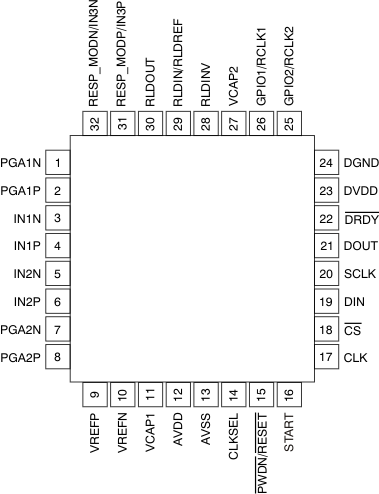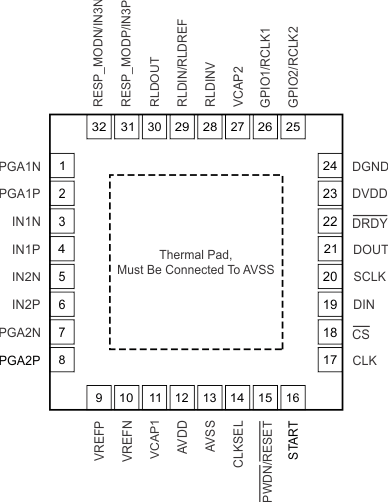SBAS502C December 2011 – April 2020 ADS1291 , ADS1292 , ADS1292R
PRODUCTION DATA.
- 1 Features
- 2 Applications
- 3 Description
- 4 Revision History
- 5 Pin Configuration and Functions
- 6 Specifications
- 7 Parameter Measurement Information
-
8 Detailed Description
- 8.1 Overview
- 8.2 Functional Block Diagram
- 8.3
Feature Description
- 8.3.1 EMI Filter
- 8.3.2
Input Multiplexer
- 8.3.2.1 Device Noise Measurements
- 8.3.2.2 Test Signals (TestP and TestN)
- 8.3.2.3 Auxiliary Differential Input (RESP_MODN/IN3N, RESP_MODN/IN3P)
- 8.3.2.4 Temperature Sensor (TEMPP, TEMPN)
- 8.3.2.5 Supply Measurements (MVDDP, MVDDN)
- 8.3.2.6 Lead-Off Excitation Signals (LoffP, LoffN)
- 8.3.2.7 Auxiliary Single-Ended Input
- 8.3.3 Analog Input
- 8.3.4 PGA Settings and Input Range
- 8.3.5 Digital Decimation Filter
- 8.3.6 Reference
- 8.3.7 Clock
- 8.3.8 Data Format
- 8.3.9 Multiple Device Configuration
- 8.3.10 ECG-Specific Functions
- 8.3.11 Setting the Device for Basic Data Capture
- 8.4 Device Functional Modes
- 8.5
Programming
- 8.5.1 SPI Interface
- 8.5.2
SPI Command Definitions
- 8.5.2.1 WAKEUP: Exit STANDBY Mode
- 8.5.2.2 STANDBY: Enter STANDBY Mode
- 8.5.2.3 RESET: Reset Registers to Default Values
- 8.5.2.4 START: Start Conversions
- 8.5.2.5 STOP: Stop Conversions
- 8.5.2.6 OFFSETCAL: Channel Offset Calibration
- 8.5.2.7 RDATAC: Read Data Continuous
- 8.5.2.8 SDATAC: Stop Read Data Continuous
- 8.5.2.9 RDATA: Read Data
- 8.5.2.10 Sending Multi-Byte Commands
- 8.5.2.11 RREG: Read From Register
- 8.5.2.12 WREG: Write to Register
- 8.6
Register Maps
- 8.6.1
User Register Description
- 8.6.1.1 ID: ID Control Register (Factory-Programmed, Read-Only) (address = 00h)
- 8.6.1.2 CONFIG1: Configuration Register 1 (address = 01h)
- 8.6.1.3 CONFIG2: Configuration Register 2 (address = 02h)
- 8.6.1.4 LOFF: Lead-Off Control Register (address = 03h)
- 8.6.1.5 CH1SET: Channel 1 Settings (address = 04h)
- 8.6.1.6 CH2SET: Channel 2 Settings (address = 05h)
- 8.6.1.7 RLD_SENS: Right Leg Drive Sense Selection (address = 06h)
- 8.6.1.8 LOFF_SENS: Lead-Off Sense Selection (address = 07h)
- 8.6.1.9 LOFF_STAT: Lead-Off Status (address = 08h)
- 8.6.1.10 RESP1: Respiration Control Register 1 (address = 09h)
- 8.6.1.11 RESP2: Respiration Control Register 2 (address = 0Ah)
- 8.6.1.12 GPIO: General-Purpose I/O Register (address = 0Bh)
- 8.6.1
User Register Description
- 9 Application and Implementation
- 10Power Supply Recommendations
- 11Layout
- 12Device and Documentation Support
- 13Mechanical, Packaging, and Orderable Information
Package Options
Mechanical Data (Package|Pins)
Thermal pad, mechanical data (Package|Pins)
- PBS|32
Orderable Information
5 Pin Configuration and Functions
PBS Package
32-Pin TQFP
Top View

Pin Functions
| PIN | FUNCTION | DESCRIPTION | ||
|---|---|---|---|---|
| NO. | PBS (TQFP) | RSM (VQFN) | ||
| 1 | PGA1N | PGA1N | Analog output | PGA1 inverting output |
| 2 | PGA1P | PGA1P | Analog output | PGA1 noninverting output |
| 3 | IN1N(1) | IN1N(1) | Analog input | Differential analog negative input 1 |
| 4 | IN1P(1) | IN1P(1) | Analog input | Differential analog positive input 1 |
| 5 | IN2N(1) | IN2N(1) | Analog input | Differential analog negative input 2 |
| 6 | IN2P(1) | IN2P(1) | Analog input | Differential analog positive input 2 |
| 7 | PGA2N | PGA2N | Analog output | PGA2 inverting output |
| 8 | PGA2P | PGA2P | Analog output | PGA2 noninverting output |
| 9 | VREFP | VREFP | Analog input/output | Positive reference voltage |
| 10 | VREFN | VREFN | Analog input | Negative reference voltage; must be connected to AVSS |
| 11 | VCAP1 | VCAP1 | — | Analog bypass capacitor |
| 12 | AVDD | AVDD | Supply | Analog supply |
| 13 | AVSS | AVSS | Supply | Analog ground |
| 14 | CLKSEL | CLKSEL | Digital input | Master clock select |
| 15 | PWDN/RESET | PWDN/RESET | Digital input | Power-down or system reset; active low |
| 16 | START | START | Digital input | Start conversion |
| 17 | CLK | CLK | Digital input | Master clock input |
| 18 | CS | CS | Digital input | Chip select |
| 19 | DIN | DIN | Digital input | SPI data in |
| 20 | SCLK | SCLK | Digital input | SPI clock |
| 21 | DOUT | DOUT | Digital output | SPI data out |
| 22 | DRDY | DRDY | Digital output | Data ready; active low |
| 23 | DVDD | DVDD | Supply | Digital power supply |
| 24 | DGND | DGND | Supply | Digital ground |
| 25 | GPIO2/RCLK2 | GPIO2/RCLK2 | Digital input/output | General-purpose I/O 2 or resp clock 2 (ADS1292R) |
| 26 | GPIO1/RCLK1 | GPIO1/RCLK1 | Digital input/output | General-purpose I/O 1 or resp clock 1 (ADS1292R) |
| 27 | VCAP2 | VCAP2 | — | Analog bypass capacitor |
| 28 | RLDINV | RLDINV | Analog input | Right leg drive inverting input; connect to AVDD if not used |
| 29 | RLDIN/ RLDREF | RLDIN/ RLDREF | Analog input | Right leg drive input to MUX or RLD amplifier noninverting input; connect to AVDD if not used |
| 30 | RLDOUT | RLDOUT | Analog output | Right leg drive output |
| 31 | RESP_MODP/ IN3P(1) | RESP_MODP/ IN3P(1) | Analog output/input | P-side respiration excitation signal for respiration (analog output) or auxiliary input 3P (analog input) |
| 32 | RESP_MODN/ IN3N(1) | RESP_MODN/ IN3N(1) | Analog output/input | N-side respiration excitation signal for respiration (analog output) or auxiliary input 3N (analog input) |
| Power Pad | — | Pad | — | Thermal pad; must be connected to AVSS |
(1) Connect unused analog inputs to AVDD.
